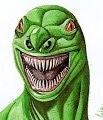@BrianEngh_Art @JCTArtStudio @NHMLA @aeroevo The ridges were likely on the outside of the lower beak, which then fit into corresponding grooves on the inside of the upper beak.
According to Peters, alvarezsaurs lived like oxpeckers and rode on the backs of larger dinosaurs like Deinocheirus.
@HodariNundu @TheItalianRobot These look a lot like David Peters' old models and paintings from the 80's-90's, I wonder if he made them.
Something not a lot of people are aware of is that Ludodactylus did not have a curved, pointed, Pteranodon-like crest as commonly portrayed.
Following up yesterday's thread, Else Bostelmann's paintings of unknown species are some of her most iconic.
The deep sea art of Else Bostelmann deserves to be more widely recognized.
@HodariNundu @Tessasaurus_rex The comb of E. regalis is more likely to be a genuine structure, since most of the skin on the upper neck and back of the head is preserved in place. However, I don't think it can yet be ruled out that is was an artifact of decay.
@AllLittleFishes interviewed me for @ArmatusO's Deep-Sea Podcast and I had a fantastic time! We discussed megalodon, Helicoprion, paleoart, Beebe's fishes, globsters, and much, much more. There's lots of paleontology and cryptozoology content to enjoy.
@VladimirDinets @MarkWitton @albertonykus @digital_duck Coelacanths were known from complete specimens 100 years before the living one was rediscovered. For example, this is Macropoma mantelli named by Agassiz in 1835.
https://t.co/MCKN1V3RVs


























